Abstract
Copper content in copper smelter slag exceeds that in copper ores, which has attracted increasing interest to recover copper from this by-product of pyrometallurgical copper production. The isopropanol-sulfuric acid-ozone system has been tested under different conditions to extract this metal from copper smelter slag containing chalcopyrite as a copper mineral. Isopropanol as a solvent played a key role in increasing the copper recovery to 87% after 5 h of leaching, while the use of an aqueous solution of sulfuric acid allowed only 13% of copper to be recovered. Iron extraction under these conditions was only 10%. The role of ozone was spectroscopically proven to oxidize ferrous ions to form ferric ions, which are effective oxidizers of chalcopyrite. The presence of copper in solution in the form of cuprous (Cu+) ions was proven electrochemically. The increased copper extraction in the solution was caused by the stabilization of cuprous ions by isopropanol. The limiting stage of the process was the chemical reaction on the chalcopyrite surface with the activation energy of 73.4 kJ mol−1.
1. Introduction
Copper smelter slag is a by-product of pyrometallurgical copper production. It is estimated that approximately 37.7 million tons of copper smelter slag is produced annually worldwide [1,2]. The disposal of these massive amounts of copper slag necessitates significant expanses of land, posing waste management issues [3,4]. Containing such toxic components as As and Cd, copper smelter slag is a potential source of pollution affecting soil, surface water and groundwater [5,6,7]. On the other hand, the copper content in this slag (about 1 wt.% or more) exceeds that in copper ores (0.3–1.7 wt.%) [8]. This has attracted increasing interest to recover copper from copper slag using various methods; among them is hydrometallurgy, involving the raw material processing with an aqueous solution of a chemical reagent, mainly mineral acids (H2SO4, HNO3, or HCl), or bases (NH3 or NaOH) [9,10,11,12,13,14,15,16]. The use of hydrometallurgy for the processing of raw materials is associated with a number of significant disadvantages, such as increased water consumption and the need to dispose of a large amount of wastewater, significant acid consumption, low selectivity in leaching, as well as silica gel formation causing difficulties in pulp filtration [17,18]. A more acceptable alternative seems to be leaching by using water-immiscible (nonpolar) organic solvents with dissolved extractants [19,20]. This new branch of extractive metallurgy, called solvometallurgy, has a number of advantages over traditional hydrometallurgy. Among them are a sharp decrease in the volume of water used and the absence of the need for wastewater disposal, the relatively easy filterability of the pulp, as well as the possibility of selective leaching [21,22,23,24].
Solvometallurgical processes have been successfully used to extract copper [23,25,26,27,28]. Raghavan and Fuerstenau developed a process of copper recovery from one of the principal oxidized copper minerals—chrysocolla—by leaching it with the extractant LIX 63 dissolved in kerosene in the presence of a small amount of ammonia; 70%–75% of copper recovery to the solution was achieved [25]. A much more effective route of chrysocolla leaching was proposed by Lukas Gijsemans and co-workers [23]. By using 50 vol.% LIX 984 N solution in a solvent, 99.9% of copper recovery was achieved after three stages of leaching.
Copper minerals in smelter slag are represented mainly by sulfides, such as bornite Cu5FeS4, chalcopyrite CuFeS2, and chalcocite Cu2S [1]; in this regard, the leaching of copper in non-aqueous solvents from sulfide minerals was of particular interest. Parker applied acetonitrile to recover copper from chalcocite by using Cu2+ ions as an oxidizer [26]. The idea was in the complex formation of copper with acetonitrile according to the reaction (1):
Cu2S + 2Cu2+ + 8CH3CN = 4[Cu(CH3CN)2]+ + S
Acetonitrile is recycled in this process by distilling the acetonitrile–water mixture; when the volume of organic solvent to water ratio is too low, the acetonitrile complex is destroyed and free (metallic) copper is released (2):
4[Cu(CH3CN)2]+ = 2Cu + 2Cu2+ + 8CH3CN
Chalcopyrite is one of the most industrially significant copper minerals [27]. Its leaching in acidic aqueous solution under non-harsh conditions (near-ambient temperatures, atmospheric pressure) is challenging because of surface passivation [28,29,30,31,32,33]. Successful attempts have been made in the field of solvometallurgical leaching of chalcopyrite [34,35,36,37,38,39]. Ethylene glycol has been proven to be an excellent media for this purpose; no passivation layer was formed on the surface of the mineral that ensured the almost quantitative recovery of copper into solution [34,35,36,37,38,39,40,41,42,43]. Solis-Marcial and Lapidus have been tested in alcoholic acid media, namely, isopropanol and methanol, for acidic leaching copper from chalcopyrite [44]. It was found that alcohol plays a beneficial role in oxidative chalcopyrite leaching, consisting of the stabilization of Cu+ ion with alcohol. Under relatively soft conditions (0.5 M H2SO4, 0.2 M CuSO4, 40 °C, atmospheric pressure, O3 flow rate), more than 80% copper was extracted into the solution. The following overall reaction has been proposed (3):
where R is the isopropanol.
12CuFeS2 + 2Cu2+ + 7O3 + 14H+ + 14R = 14Cu+R + 7H2O + 7O2 + 14S + 10FeS + 2Fe2+
About 80% copper was recovered into solution under the following conditions: 0.5 M H2SO4, 6.9 M methanol (70%–30% v/v), 0.2 M CuSO4, O3 flow rate 0.035 g min−1, pulp density 3 g/280 mL.
In the present paper, the «isopropanol-sulfuric acid-ozone» system has been tested under different conditions to extract copper from copper smelter slag, collected from «Kazakhmys Smelting» (Balkhash, Kazakhstan). The use of expensive copper sulfate for leaching relatively copper-poor raw materials is impractical; therefore, this reagent was not applied. Сopper smelter slag is a much more difficult system to leach than the chalcopyrite, as it also contains a number of other minerals, most notably fayalite. Based on the best knowledge of the authors, no study has yet been undertaken to evaluate the indicated system for the leaching of copper smelter slag.
2. Materials and Methods
2.1. Raw Material
A sample of copper smelter slag was collected from «Kazakhmys Smelting» copper plant (Kazakhstan, Balkhash). Milled and sieved (~90% of particles ≤74 μm) slag was subjected to leaching.
2.2. Reagents
Isopropanol (>99.5%), sulfuric acid (96%), 1,10—phenantroline (>99%), sodium acetate anhydrous (>99%), and sodium hydroxide (≥97%) were purchased from Sigma-Aldrich (Darmstadt, Germany) and used without further purification. Bidistilled water was used in all washing and cleaning procedures.
2.3. Leaching Procedure
The batch leaching experiments were performed in a 200 mL round-bottom glass reactor, equipped with a thermometer. In the reactor, 100 mL of sulfuric acid solution 0.4 M (or 2.0 M, respectively) in isopropanol was added. In the case of leaching in an aqueous solution, bidistilled water was used instead of isopropanol. Then, the reactor was placed on the magnetic stirrer (IKA RT 5, Darmstadt, Germany), and the required temperature was set. Once the desired temperature was reached, 10 g of the slag sample was placed into the solution; thus, the pulp density was 10% in all leaching tests. When using ozone, it bubbled into the solution throughout the leaching time. The ozone (0.05 g/min) was produced by supplying oxygen into the ozonizer (Lepse Ozon 5–04, Kirov, Russia). The copper and iron concentrations were determined by taking liquid samples of the solution every hour.
To evaluate the efficiency of leaching, the recovery of copper and iron (α) was calculated using the following formula:
where and are masses of metal in solution and initial sample, respectively.
Once the leaching procedure was completed, solid residue after drying was subjected to XRD analysis.
2.4. Electrodeposition of Copper
Electrochemical deposition of copper was performed by using the H-type electrolytic cell (CH2003, Beijing, China) with two separate compartments of 30 mL each. A copper plate was used as a cathode and a lead dioxide plate was used as an anode; both plates had a geometrical surface area of 1.25 cm2. Before experiments, the volume of leachate was reduced by solvent evaporation 8 times to increase copper concentration in the solution. The resulting solution (about 12 mL) was placed into the cathodic compartment, while the same volume of 0.4 M sulfuric acid in isopropanol was placed into the anodic compartment. The electrolysis was performed under galvanostatic conditions at a current density of 0.5 A dm−2, and the current was supplied by potentiostat-galvanostat (Elins P-40X, Chernogolovka, Russia). The duration of electrolysis was 1 h; every 15 min, samples were taken from the catholyte and anolyte with a micropipette to determine copper and ferric (Fe3+) ions, and the masses of these particles in solution were calculated.
2.5. Analytical Techniques
The initial slag’s Cu and Fe content was determined using atomic absorption spectrometry (AAS) on an AA-6200 spectrometer (Shimadzu, Tokyo, Japan). AAS was used to determine the content of the mentioned metals in solid samples after preliminary decomposition with concentrated nitric acid at 90–95 °C and a pressure of 10 atm.
The XRD patterns were recorded by a D8 Advance diffractometer (Bruker, MA, USA) with CuKα (40 kV, 40 mA) radiation.
For measuring the concentration of Fe2+ in the leachates, the technique proposed by Agustina and co-workers [45] was applied. The technique is based on the selective complex formation of Fe (II) with 1, 10—phenantroline. The absorption of the complex solution is very sensitive to the concentration of Fe2+ in the solution.
To prepare leaching solution samples for Fe2+ determination, 1 μL of the leachate was placed in a 1 L flask by using a micropipette (Rainin, Mettler Toledo, Columbus, OH, USA) and the volume of the solution was brought to 1 L with bidistilled water. Then, 100 μL of the resulting solution was mixed with 1 mL of 1, 10—phenantroline solution (0.12 wt.%), 1 mL of sodium acetate buffer solution (obtained by mixing equal volumes of 6 M CH3COOH and 5 M NaOH) and 8 mL of bidistilled water.
UV–Vis absorption spectra were recorded on СF-56 (St. Petersburg, Russia) spectrophotometer to quantify the Fe2+ concentration in the solution.
The following relationship between the absorbance (A) at 510 nm and Fe2+ concentration (ppm, or μg mL−1) was used [43]:
A = 0.20423 C + 0.00716, R2 = 0.99994
The following equation was used for Fe3+ determination in the leachate:
where is the total concentration of Fe in the leachate identified by AAS.
3. Results and Discussion
3.1. Characterization of Initial Copper Slag
The chemical composition (wt.%) of the slag sample was: Fe 24.6, Si 38.7, Zn 3.2, Cu 1.9, S 2.7.
Fayalite (Fe2SiO4), ferrosilite (FeSiO3), zinc ferrite (ZnFe2O4) and chalcopyrite (CuFeS2) have been identified as crystalline phases in the initial sample according to XRD analysis (Figure 1). The very high background and weak intensities of the diffraction lines indicate that the slag contains a significant amount of amorphous material. Amorphous phase content is high in slags that have been cooled rapidly [46].
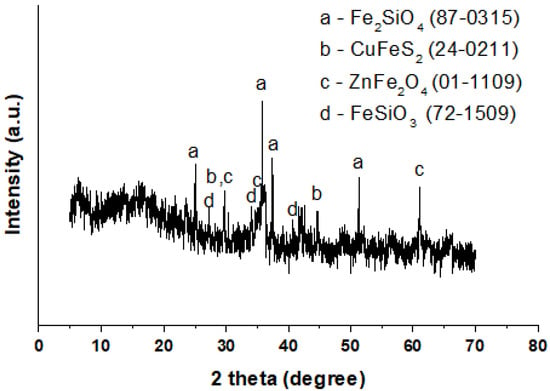
Figure 1.
XRD pattern of the initial slag.
3.2. Leaching Experiments
Since copper in the slag sample was represented by chalcopyrite (at least in the crystalline part of the slag), it was necessary to select the conditions for the dissolution of this mineral. This task is not easy, since the surface of chalcopyrite undergoes passivation under the influence of acids, which prevents an acceptable extraction of copper into solution [47]. To achieve the desired solution potential, chalcopyrite must be leached in polar organic solvents such as isopropanol in the presence of an oxidizing agent [43]. Ozone (O3) was applied for this purpose in the present work as it was successfully exploited for leaching chalcopyrite in polar organic solvents [44]. Being a powerful two-electron oxidant, ozone has one of the highest oxidation potentials (2.07 V vs. SHE).
Figure 2 depicts the relationship between the duration of leaching and the extraction of copper and iron from the slag into the solution.
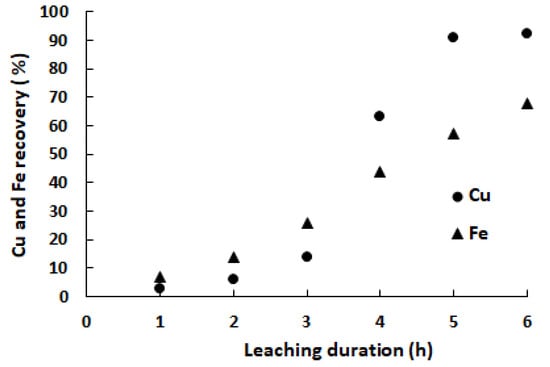
Figure 2.
Copper and iron extraction from copper smelter slag vs. time (2 M H2SO4 in isopropanol; O3 flow rate of 0.05 g min−1; pulp density of 10%; 70 °С).
Both metals showed a general trend of increasing recovery after 5 h of leaching. However, the progression in the percentage of recovery for copper and iron was different. During the first three hours of leaching, the recovery of copper was only 14%, while in the next hour the recovery increased to 63%. The maximum extraction of copper reached 91% after 5 h of leaching and remained virtually unchanged during the next hour of slag contact with the solution. The achieved copper recovery was higher than that described by Solis-Marcial and Lapidus [44]; moreover, in our case, the pulp density was also higher.
For iron, the progression in the percentage of recovery over time was close to linear; in the first hour of leaching, the recovery was 7%, while the maximum recovery in 6 h was 68%, with the uptrend continuing.
The next series of experiments were carried out at an acid concentration of 0.4 M; the rest of the conditions were the same as in Figure 2. The results of the experiments are presented in Figure 3.
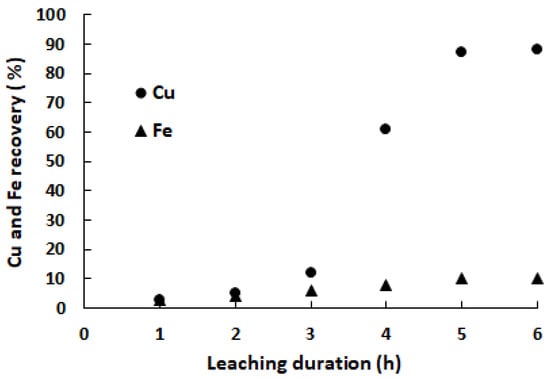
Figure 3.
Copper and iron extraction from copper smelter slag vs. time (0.4 M H2SO4 in isopropanol; O3 flow rate of 0.05 g min−1; pulp density of 10%; 70 °С).
In the case of copper, the overall trend and recovery values have changed slightly from those observed in Figure 2. The maximum recovery was 87% in the first 5 h of leaching (against 91% shown in Figure 2). For iron, the picture turned out to be completely different. A decrease in the concentration of sulfuric acid from 2 M to 0.4 M led to a sharp decrease in the iron extraction, the maximum value of which was 10% (against 68% at 2 M H2SO4) with a plateau after 5 h of leaching.
Under both conditions (presented in Figure 2 and Figure 3) recovery of copper into solution was relatively low in the first 3 h and increased sharply in the next hour of leaching. A possible reason was the accumulation of the leaching agent in solution (other than sulfuric acid and ozone) during the first hours of leaching and its subsequent interaction with the slag sample. Such a leaching agent could be Fe3+ ions. Figure 4 shows the change in the concentration of iron ions in the solution over time, including Fe3+ ions. At the end of the first hour of leaching, the total concentration of iron was 361 mg L−1, while in the next 3 h, the increase in iron concentration was about 490 mg L−1. The content of Fe3+ ions during the first hour was 41 mg L−1 with a sharp increase in the second and third hours of leaching (up to 627 and 1161 mg L−1, respectively). Between the third and fourth hours of leaching, the content of Fe3+ remained approximately at the same level, with an increase (by 550 mg L−1) in the fifth hour of leaching.
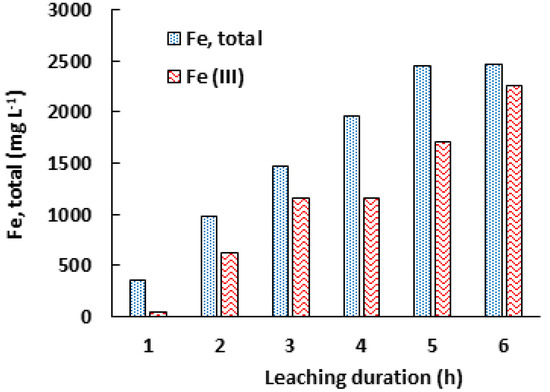
Figure 4.
Change in the concentration of Fe(total) and Fe3+ ions in solution over leaching time.
A sharp increase in the concentration of Fe3+ is caused by the known processes of oxidation of Fe2+ ions by ozone [48]:
Fe2+ + O3 = FeO2+ + O•
FeO2+ + H2O = Fe3+ + OH• + OH−
FeO2+ + Fe2+ + 2H+ = 2Fe3+ + H2O
As was demonstrated by Zhang and co-workers, in the O3/Fe2+, the ferrous ion can promote the breakdown of ozone (Equation (7)) leading to the formation of oxygen and hydroxyl radicals (Equations (7) and (8)) [48]. In addition, ferrous ions oxidized with the formation of ferric ions (Equations (8) and (9)). Thus, in the O3/Fe2+ system, there are several types of oxidizing particles that can act as leaching agents.
According to Figure 4, Fe3+ ion accumulation occurred during the first three hours of leaching, while the concentration of these ions practically did not change during the fourth hour. These data are consistent with those shown in Figure 3; it was in the fourth hour that copper ions accumulated in the solution, apparently due to the following reaction [34]:
CuFeS2 + 3Fe3+ = 4Fe2+ + Cu+ + 2S
This reaction explains the steadiness in the concentration of ferric ions in the fourth hour of leaching, where almost 50% of copper slag was recovered. In the next hour, 25% of copper was extracted, and the consumption of ferric ions was lower, which led to an increase in their concentration in the solution.
The next series of experiments was devoted to the study of ozone flow rate, up to its absence, for the extraction of copper into solution (Figure 5). The rest of the parameters were the same as in Figure 4.
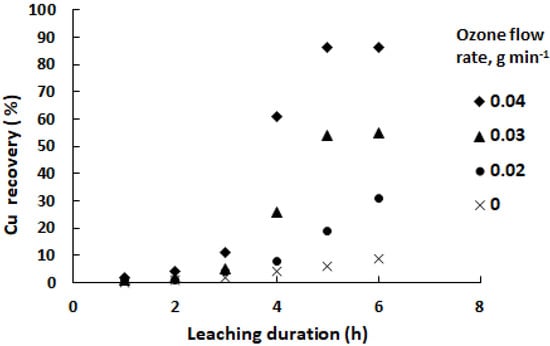
Figure 5.
Effect of ozone flow rate on copper extraction from copper smelter slag (0.4 M H2SO4 in isopropanol; pulp density of 10%; 70 °С).
Extraction of copper into the solution at an O3 flow rate of 0.04 g min−1 almost coincided with that at 0.05 g min−1, while reducing this parameter to 0.03 g min−1 sharply reduced the maximum extraction of copper to 55% (compared to 86% at 0.04 and 0.05 g min−1 of O3). In both cases, copper extraction plateaued after the fifth hour of leaching. The subsequent decrease in the ozone flow rate expectedly reduced the copper extraction into the solution, and with an increase in the duration of leaching, an upward trend was observed up to the entire time interval under study.
Figure 6 shows the X-ray diffraction pattern of the leach residue after 5 h of leaching under the conditions presented in Figure 5.
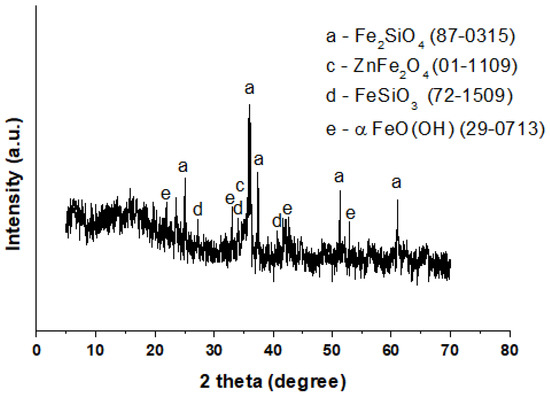
Figure 6.
XRD pattern of the copper slag leaching residue (0.4 M H2SO4; pulp density of 10%; 70 °С; 5 h).
A comparison of Figure 1 and Figure 6 revealed the disappearance of diffraction peaks associated with chalcopyrite; at the same time, peaks appeared at 22, 33, 41 and 54°, belonging to goethite (α—FeO(OH)). This compound is formed following the process known as iron precipitation in the form of goethite [49]:
2Fe2+ + 0.5O2 + 3H2O = 2FeO(OH) + 4H+
To elucidate the role of isopropanol in copper slag leaching, additional experiments were carried out under the conditions presented in Figure 3; the only exception was the nature of the solvent (water was used instead of isopropanol). The extraction of copper and iron into the solution depending on the time is shown in Figure 7. The extraction of iron into an aqueous solution was practically identical to that observed in an isopropanol solution. Copper recovery, on the contrary, declined sharply: an upward trend was observed throughout the leaching, with a maximum of 13% after 6 h of leaching. Thus, the use of isopropanol as a solvent played a decisive role in the extraction of copper, while the extraction of iron turned out to be practically insensitive to the replacement of the solvent.
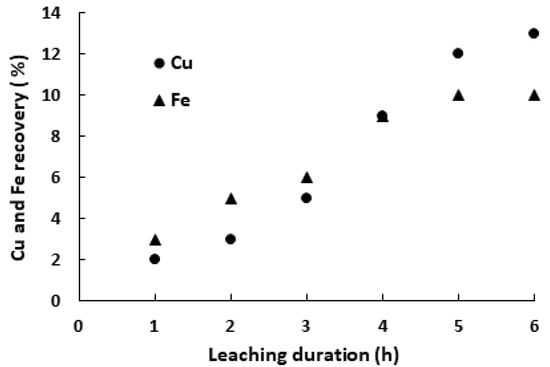
Figure 7.
Copper and iron extraction from copper smelter slag vs. time (0.4 M H2SO4 in water; O3 flow rate of 0.05 g min−1; pulp density of 10%; 70 °С).
3.3. Kinetic Study
A shrinking core model is widely used to describe the leaching process [50,51,52]. Depending on the nature of the rate-limiting step, the relationship between the metal fraction extracted to the solution (XMe) and the rate constant of chemical reaction (k) at a certain leaching time (τ) is described by the following models [53]:
The equations presented fit the processes with the rate-limiting step of the mass transfer in the fluid layer that surrounds the solid particle (Equation (12)), the chemical reaction on the surface of the particle (Equation (13)), and the mass transfer in the layer of solid products of chemical reaction (Equation (14)).
To reveal the actual rate-limiting step of the copper leaching process under study, the dependences of copper extraction on the leaching duration in accordance with models (12)–(14) were found (Figure 8). A three-hour leaching period (from the second to the fifth hour) was chosen, in which significant changes in the extraction of copper into solution were observed; copper recovery data was taken from Figure 7.
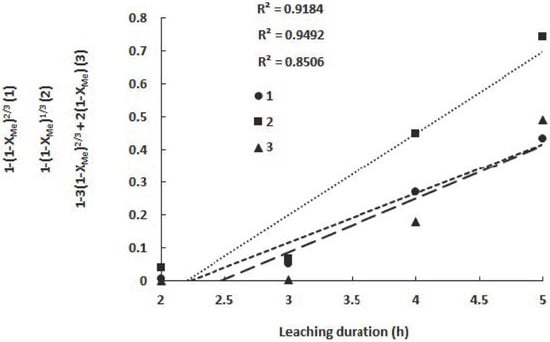
Figure 8.
The consistency of leaching models with experimental data on copper recovery (0.4 M H2SO4 in isopropanol; O3 flow rate of 0.05 g min−1; pulp density of 10%; 70 °С).
The coefficients of determination (R2) for all three models were quite high; at the same time, the highest R2 was observed for the model corresponding to Equation (13), indicating that the limiting stage of copper extraction is the chemical reaction on the surface of the particle. A similar conclusion about the limiting stage of chalcopyrite leaching with iron (III) chloride in ethylene glycol was made by Li et al. [34].
To reveal the effect of temperature on the kinetics of copper leaching from slag, leaching experiments were carried out at 30 and 50 °С; the rest of the conditions were the same as in Figure 7, except for the ozone flow rate, which was 0.04 g min−1. The dependence of copper extraction on leaching temperature is presented in Figure 9. Lowering the temperature to 50 °С and further to 30 °С significantly reduced copper extraction into the solution. With increasing leaching duration at both temperatures, an upward trend was observed, with maximums of 9% (30 °C) and 24% (50 °C) after 6 h.

Figure 9.
Effect of temperature on copper extraction from copper smelter slag (0.4 M H2SO4 in isopropanol; O3 flow rate of 0.04 g min−1; pulp density of 10%; 70 °С).
To calculate the apparent rate constant of chemical reaction, the data from Figure 9 were used in combination with Equation (13); the resulting plot of 1 − (1 − XMe)1/3 vs. leaching duration is presented in Figure 10. The chemical reaction rate constants (h−1) at indicated temperatures are: 0.0069 (30 °С), 0.0258 (50 °С), and 0.2258 (70 °С). Arrhenius plot for copper recovery from copper smelter slag was created by using these calculated rate constants (Figure 11). The linear fitting confirms that the copper recovery into the solution is controlled by the chemical reaction on the slag’s surface.
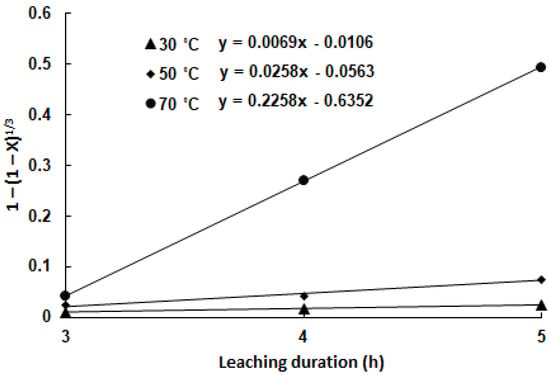
Figure 10.
A plot of 1 − (1 − XMe)1/3 vs. leaching duration for copper recovery from copper smelter slag (0.4 M H2SO4 in isopropanol; O3 flow rate of 0.04 g min−1; pulp density of 10%; 70 °С).
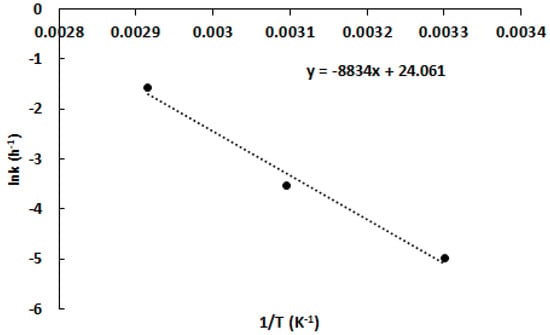
Figure 11.
Arrhenius plot for copper leaching from copper smelter slag (0.4 M H2SO4; O3 flow rate of 0.04 g min−1; pulp density of 10%; 70 °С).
The activation energy (Ea) and pre-exponential factor (A) of the overall chemical reaction determining the copper extraction into solution were determined using Arrhenius’s law (Equation (15)) [54]:
where k is the rate constant of chemical reaction, R is the universal gas constant, and T is absolute temperature).
The calculated Ea and A were 73.4 kJ mol−1 and 24.06 h−1, respectively; both values are in the same range as those reported for chalcopyrite leaching [55].
3.4. Electrochemical Deposition of Copper
Electrochemical deposition has been used to determine the oxidation state of copper in the solution after leaching. During the entire time of electrolysis, copper and iron ions were not found in the anolyte. In the catholyte, a decrease in the mass of copper took place; the total mass of iron in the solution remained constant, but the proportion of ferric ions decreased.
Table 1 shows the change in the masses of copper and Fe3+ ions in the solution during electrolysis. The decrease in the mass of ferric ions is caused by their cathodic reduction with the formation of ferrous (Fe2+) ions:
Fe3+ + e = Fe2+

Table 1.
Change in masses of copper and ferric ions in solution during electrolysis.
The decrease in the mass of copper ions is caused by their deposition on the cathode surface. Isopropanol is electrochemically stable under the conditions under consideration [56], and the cathodic release of hydrogen gas was not visually observed. Thus, the electric current was consumed only for reaction (16) and for the electrodeposition of copper.
Every 15 min, 1.563 mA h of electricity passed through the electrolyzer. Considering that 0.478 mA h is required to reduce 1 mg of iron ions, 0.419 mA h was consumed for every 1 mg of copper deposited. This amount of electricity corresponds to the cathodic reduction of cuprous (Cu+) ions:
Cu+ + e = Cu0
Because cupric (Cu2+) ions are more stable than cuprous ions, cathodic reduction of cupric ions was expected, resulting in a lower (twice) rate of copper ion consumption than observed. This circumstance is caused by the stabilization of cuprous ions by isopropanol, as Marcial and Lapidus stated [44]. An electrochemical method was used to demonstrate the fact that cuprous ions can be stabilized with isopropanol.
4. Conclusions
The «isopronalol—sulfuric acid—ozone» system was found to be effective for selective copper recovery from copper smelter slag. The role of isopropanol in the acid leaching of slag was to increase the degree of copper extraction in comparison with an aqueous solution under conditions of relatively low initial acidity. Under these conditions, most of the leached iron precipitated with the formation of goethite. Due to the stabilization of copper (I) ions with isopropanol, copper did not precipitate in the form of poorly soluble compounds, but remained in the solution. The role of ozone was to oxidize ferrous ions to form ferric ions, which are effective oxidizers of chalcopyrite. These conclusions were confirmed spectroscopically, as well as electrochemically.
The optimal conditions for copper leaching from copper smelter slag in the «isopronalol—sulfuric acid—ozone» system was determined as follows: 0.4 M H2SO4; O3 flow rate of 0.04 g min−1; pulp density of 10%; 70 °С. Under these conditions, copper extraction was 87%, while only 10% of iron passed to the solution. A kinetic study revealed that the limiting stage of copper recovery was the chemical reaction on the surface of chalcopyrite particle.
Author Contributions
Conceptualization, R.N.; methodology, G.K.; investigation, R.N. and G.K.; resources, R.N.; writing—original draft preparation, R.N. and G.K.; writing—review and editing, R.N.; visualization, R.N. and G.K; project administration, R.N.; funding acquisition, R.N. All authors have read and agreed to the published version of the manuscript.
Funding
This research was funded by the Science Committee of the Ministry of Education and Science of the Republic of Kazakhstan (Grant No. AP08856414).
Data Availability Statement
The data supporting the results can be made available from the corresponding author upon request.
Conflicts of Interest
The authors declare no conflict of interest.
References
- Phiri, T.C.; Singh, P.; Nikoloski, A.N. The potential for copper slag waste as a resource for a circular economy: A review–Part II. Miner. Eng. 2021, 172, 107150. [Google Scholar] [CrossRef]
- Gorai, B.; Jana, R.K. Characteristics and utilisation of copper slag—A review. Resour. Conserv. Recycl. 2003, 39, 299–313. [Google Scholar] [CrossRef]
- Piatak, N.M.; Parsons, M.B.; Seal II, R.R. Characteristics and environmental aspects of slag: A review. Appl. Geochem. 2015, 57, 236–266. [Google Scholar] [CrossRef]
- Alter, H. The composition and environmental hazard of copper slags in the context of the Basel Convention. Resour. Conserv. Recycl. 2005, 43, 353–360. [Google Scholar] [CrossRef]
- Parsons, M.B.; Bird, D.K.; Einaudi, M.T.; Alpers, C.N. Geochemical and mineralogical controls on trace element release from the Penn Mine base-metal slag dump, California. Appl. Geochem. 2001, 16, 1567–1593. [Google Scholar] [CrossRef]
- Potysz, A.; Pędziwiatr, A.; Hedwig, S.; Lenz, M. Bioleaching and toxicity of metallurgical wastes. J. Environ. Chem. Eng. 2020, 8, 104450. [Google Scholar] [CrossRef]
- Li, Z.; Ma, G.; Zhang, X.; Li, J. Characteristics and chemical speciation of waste copper slag. Environ. Sci. Pollut. Res. 2021, 28, 20012–20022. [Google Scholar]
- Schlesinger, M.E.; Sole, K.C.; Davenport, W.G.; Alvear, G.R. Extractive Metallurgy of Copper; Elsevier: Amsterdam, The Netherlands, 2021. [Google Scholar]
- Banza, A.N.; Gock, E.; Kongolo, K. Base metals recovery from copper smelter slag by oxidising leaching and solvent extraction. Hydrometallurgy 2002, 67, 63–69. [Google Scholar] [CrossRef]
- Yang, Z.; Rui-Lin, M.; Wang-Dong, N.; Hui, W. Selective leaching of base metals from copper smelter slag. Hydrometallurgy 2010, 103, 25–29. [Google Scholar] [CrossRef]
- Shi, G.; Liao, Y.; Su, B.; Zhang, Y.; Wang, W.; Xi, J. Kinetics of copper extraction from copper smelting slag by pressure oxidative leaching with sulfuric acid. Sep. Purif. Technol. 2020, 241, 116699. [Google Scholar] [CrossRef]
- Arslan, C.; Arslan, F. Recovery of copper, cobalt, and zinc from copper smelter and converter slags. Hydrometallurgy 2002, 67, 1–7. [Google Scholar] [CrossRef]
- Kaksonen, A.H.; Särkijärvi, S.; Peuraniemi, E.; Junnikkala, S.; Puhakka, J.A.; Tuovinen, O.H. Metal biorecovery in acid solutions from a copper smelter slag. Hydrometallurgy 2017, 168, 135–140. [Google Scholar] [CrossRef]
- Mussapyrova, L.; Nadirov, R.; Baláž, P.; Rajňák, M.; Bureš, R.; Baláž, M. Selective room-temperature leaching of copper from mechanically activated copper smelter slag. J. Mater. Res. Technol. 2021, 12, 2011–2025. [Google Scholar]
- Nadirov, R.; Syzdykova, L.; Zhussupova, A. Copper smelter slag treatment by ammonia solution: Leaching process optimization. J. Cent. South Univ. 2017, 24, 2799–2804. [Google Scholar]
- Nadirov, R.K.; Mussapyrova, L.A. Copper smelter slag leaching by using H2SO4 in the presence of dichromate. J. Chem. Technol. Metall. 2019, 54, 657–662. [Google Scholar]
- Free, M.L. Hydrometallurgy: Fundamentals and applications; Springer Nature: Berlin, Germany, 2021. [Google Scholar]
- Gupta, C.K.; Mukherjee, T.K. Hydrometallurgy in Extraction Processes; CRC Press: Boca Raton, FL, USA, 2017. [Google Scholar]
- Binnemans, K.; Jones, P.T. Solvometallurgy: An emerging branch of extractive metallurgy. J. Sustain. Metall. 2017, 3, 570–600. [Google Scholar]
- Nadirov, R.; Karamyrzayev, G. Enhancing zinc ferrite hydrochloric acid leaching by using isopropanol as a solvent. Min. Metall. Explor. 2022, 39, 1743–1751. [Google Scholar] [CrossRef]
- Steer, J.M.; Griffiths, A.J. Investigation of carboxylic acids and non-aqueous solvents for the selective leaching of zinc from blast furnace dust slurry. Hydrometallurgy 2013, 140, 34–41. [Google Scholar]
- Girgin, I.; Oner, M.; Turker, L. Leaching of hematite in non-aqueous and mixed aqueous EtOH—HCl solutions. Int. J. Miner. Processing 1986, 17, 121–130. [Google Scholar] [CrossRef]
- Gijsemans, L.; Roosen, J.; Riano, S.; Jones, P.T.; Binnemans, K. Ammoniacal solvoleaching of copper from high-grade chrysocolla. J. Sustain. Metall. 2020, 6, 589–598. [Google Scholar]
- Palden, T.; Regadío, M.; Onghena, B.; Binnemans, K. Selective metal recovery from jarosite residue by leaching with acid-equilibrated ionic liquids and precipitation-stripping. ACS Sustain. Chem. Eng. 2019, 7, 4239–4246. [Google Scholar] [CrossRef]
- Raghavan, S.; Fuerstenau, D.W. A Lyometallurgical Process for Leaching Copper from Chrysocolla. In Hydrometallurgy Fundamentals, Technology and Innovations; Proceedings of the Milton E.; Wordsworth (IV) Int. Symposium on Hydrometallurgy, 1993; pp. 283–297. [Google Scholar]
- Parker, A.J. Hydrometallurgy of copper and silver in solvent mixtures. Search 1973, 4, 426–432. [Google Scholar]
- Turan, M.D.; Silva, J.P.; Sarı, Z.A.; Nadirov, R.; Toro, N. Dissolution of Chalcopyrite in Presence of Chelating Agent and Hydrogen Peroxide. Trans. Indian Inst. Met. 2022, 75, 273–280. [Google Scholar] [CrossRef]
- O’Connor, G.M.; Eksteen, J.J. A critical review of the passivation and semiconductor mechanisms of chalcopyrite leaching. Miner. Eng. 2020, 154, 106401. [Google Scholar] [CrossRef]
- Li, Y.; Kawashima, N.; Li, J.; Chandra, A.P.; Gerson, A.R. A review of the structure, and fundamental mechanisms and kinetics of the leaching of chalcopyrite. Adv. Colloid Interface Sci. 2013, 197, 1–32. [Google Scholar] [CrossRef]
- Koleini, S.J.; Aghazadeh, V.; Sandström, Å. Acidic sulphate leaching of chalcopyrite concentrates in presence of pyrite. Miner. Eng. 2011, 24, 381–386. [Google Scholar] [CrossRef]
- Hackl, R.P.; Dreisinger, D.B.; Peters, E.; King, J.A. Passivation of chalcopyrite during oxidative leaching in sulfate media. Hydrometallurgy 1995, 39, 25–48. [Google Scholar] [CrossRef]
- Bogdanovic, G.D.; Petrovic, S.; Sokic, M.; Antonijevic, M.M. Chalcopyrite leaching in acid media: A review. Metall. Mater. Eng. 2020, 26, 177–198. [Google Scholar] [CrossRef]
- Harmer, S.L.; Thomas, J.E.; Fornasiero, D.; Gerson, A.R. The evolution of surface layers formed during chalcopyrite leaching. Geochim. Cosmochim. Acta 2006, 70, 4392–4402. [Google Scholar] [CrossRef]
- Li, X.; Monnens, W.; Li, Z.; Fransaer, J.; Binnemans, K. Solvometallurgical process for extraction of copper from chalcopyrite and other sulfidic ore minerals. Green Chem. 2020, 22, 417–426. [Google Scholar] [CrossRef] [Green Version]
- Carlesi, C.; Harris, R.C.; Abbott, A.P.; Jenkin, G.R. Chemical Dissolution of Chalcopyrite Concentrate in Choline Chloride Ethylene Glycol Deep Eutectic Solvent. Minerals 2022, 12, 65. [Google Scholar] [CrossRef]
- Mahajan, V.; Misra, M.; Zhong, K.; Fuerstenau, M.C. Enhanced leaching of copper from chalcopyrite in hydrogen peroxide–glycol system. Miner. Eng. 2007, 20, 670–674. [Google Scholar] [CrossRef]
- Tehrani, M.E.H.N.; Naderi, H.; Rashchi, F. Electrochemical study and XPS analysis of chalcopyrite dissolution in sulfuric acid in the presence of ethylene glycol. Electrochim. Acta 2021, 369, 137663. [Google Scholar] [CrossRef]
- Ruiz-Sánchez, Á.; Lapidus, G.T. Study of chalcopyrite leaching from a copper concentrate with hydrogen peroxide in aqueous ethylene glycol media. Hydrometallurgy 2017, 169, 192–200. [Google Scholar] [CrossRef]
- Ruiz-Sánchez, A.; Lázaro, I.; Lapidus, G.T. Improvement effect of organic ligands on chalcopyrite leaching in the aqueous medium of sulfuric acid-hydrogen peroxide-ethylene glycol. Hydrometallurgy 2020, 193, 105293. [Google Scholar] [CrossRef]
- Ruiz-Sánchez, A.; Lapidus, G.T. Electrochemical and leaching studies to better understand the role of ethylene glycol in the oxidative acid dissolution of chalcopyrite. Electrochim. Acta 2022, 418, 140343. [Google Scholar] [CrossRef]
- Ruiz-Sánchez, A.; Lapidus, G.T. A study to understand the role of ethylene glycol in the oxidative acid dissolution of chalcopyrite. Miner. Eng. 2022, 180, 107502. [Google Scholar] [CrossRef]
- Ghomi, M.A.; Mozammel, M.; Moghanni, H.; Shahkar, L. Atmospheric leaching of chalcopyrite in the presence of some polar organic reagents: A comparative study and optimization. Hydrometallurgy 2019, 189, 105120. [Google Scholar] [CrossRef]
- Castillo-Magallanes, N.; Cruz, R.; Lázaro, I. Effect of organic agents on the oxidation process of chalcopyrite in a sulfuric acid solution. Electrochim. Acta 2020, 355, 136789. [Google Scholar] [CrossRef]
- Solis-Marcial, O.J.; Lapidus, G.T. Chalcopyrite leaching in alcoholic acid media. Hydrometallurgy 2014, 147, 54–58. [Google Scholar] [CrossRef]
- Agustina, E.; Goak, J.; Lee, S.; Seo, Y.; Park, J.Y.; Lee, N. Simple and precise quantification of iron catalyst content in carbon nanotubes using UV/Visible spectroscopy. Chem. Open 2015, 4, 613–619. [Google Scholar] [CrossRef] [PubMed] [Green Version]
- Wang, D.; Wang, Q.; Huang, Z. Reuse of copper slag as a supplementary cementitious material: Reactivity and safety. Resour. Conserv. Recycl. 2020, 162, 105037. [Google Scholar] [CrossRef]
- de Oliveira, C.; de Lima, G.F.; de Abreu, H.A.; Duarte, H.A. Reconstruction of the Chalcopyrite Surfaces: A DFT Study. J. Phys. Chem. C 2012, 116, 6357–6366. [Google Scholar] [CrossRef]
- Rekhate, C.V.; Srivastava, J.K. Recent advances in ozone-based advanced oxidation processes for treatment of wastewater-A review. Chem. Eng. J. Adv. 2020, 3, 100031. [Google Scholar] [CrossRef]
- Chang, Y.; Zhai, X.; Li, B.; Fu, Y. Removal of iron from acidic leach liquor of lateritic nickel ore by goethite precipitate. Hydrometallurgy 2010, 101, 84–87. [Google Scholar] [CrossRef]
- Gbor, P.K.; Jia, C.Q. Critical evaluation of coupling particle size distribution with the shrinking core model. Chem. Eng. Sci. 2004, 59, 1979–1987. [Google Scholar] [CrossRef]
- Wanta, K.C.; Astuti, W.; Perdana, I.; Petrus, H.T.B.M. Kinetic study in atmospheric pressure organic acid leaching: Shrinking core model versus lump model. Minerals 2020, 10, 613. [Google Scholar] [CrossRef]
- Velardo, A.; Giona, M.; Adrover, A.; Pagnanelli, F.; Toro, L. Two-layer shrinking-core model: Parameter estimation for the reaction order in leaching processes. Chem. Eng. J. 2002, 90, 231–240. [Google Scholar] [CrossRef]
- Safari, V.; Arzpeyma, G.; Rashchi, F.; Mostoufi, N. A shrinking particle—shrinking core model for leaching of a zinc ore containing silica. Int. J. Miner. Processing 2009, 93, 79–83. [Google Scholar] [CrossRef]
- Levenspiel, O. Chemical Reaction Engineering. In Chichester Weinheim Brisbane Singapore Toronto; John Wiley & Sons: New York, NY, USA, 1999; p. 684. [Google Scholar]
- Hidalgo, T.; Kuhar, L.; Beinlich, A.; Putnis, A. Kinetic study of chalcopyrite dissolution with iron (III) chloride in methanesulfonic acid. Miner. Eng. 2018, 125, 66–74. [Google Scholar] [CrossRef]
- Hammerich, O. Organic Electrochemistry; Speiser, B., Ed.; CRC Press: Boca Raton, FL, USA, 2016; pp. 150–154. [Google Scholar]
Publisher’s Note: MDPI stays neutral with regard to jurisdictional claims in published maps and institutional affiliations. |
© 2022 by the authors. Licensee MDPI, Basel, Switzerland. This article is an open access article distributed under the terms and conditions of the Creative Commons Attribution (CC BY) license (https://creativecommons.org/licenses/by/4.0/).